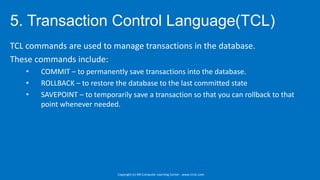Introduction to SQL
- 1. Copyright (c) NR Computer Learning Center . www.nrclc.com Dr. Vazi Okhandiar, DBA, MBA, MSCS, PMP, MCT Introduction to SQL
- 2. Copyright (c) NR Computer Learning Center . www.nrclc.com 5 Segments of SQL âĒData Definition Language (DDL) âĒData Manipulation Language (DML) âĒData Query Language (DQL) âĒData Control Language (DCL) âĒTransaction Control Language(TCL)
- 3. Copyright (c) NR Computer Learning Center . www.nrclc.com SQL Language âĒ Structured Query language (SQL) (pronounced "sequel") is an "English-like language" that allows users to easily and quickly access data from a database. It is a powerful language to offer programmers all the capability and flexibility they require to access & manipulate data in a database. âĒ SQL was developed and defined by IBM Research and refined by the American National Standards Institute (ANSI) as the standard language for relational database management systems.
- 4. Copyright (c) NR Computer Learning Center . www.nrclc.com Relational Database Management System âĒ A Relational database (RDBMS) consists of one or more tables with a relationship between the tables. âĒ The Relational databases also include tools for âĒ writing queries âĒ creating forms for entering data âĒ developing reports for presenting data in a visually appealing format âĒ writing stored procedures for executing a program within the database âĒ developing customized functions âĒ developing triggers to be automatically invoked by an event. âĒ Users can create, read, update, and delete (CRUD) data using SQL Language.
- 5. Copyright (c) NR Computer Learning Center . www.nrclc.com Introduction to SQL SQL language statements can be divided into the following categories: âĒData Definition Language (DDL) âĒData Manipulation Language (DML) âĒData Query Language (DQL) âĒData Control Language (DCL) âĒTransaction Control Language(TCL)
- 6. Copyright (c) NR Computer Learning Center . www.nrclc.com SQL DDL CREATE ALTER DROP RENAME TRUNCATE COMMENT DML INSERT UPDATE DELETE DQL SELECT DCL GRANT REVOKE TCL COMMIT ROLLBACK SAVEPOINT
- 7. Copyright (c) NR Computer Learning Center . www.nrclc.com Free SQL Online IDE âĒ https://www.mycompiler.io/new/sql âĒ https://www.w3schools.com/sql/trysql.asp?filename=trys ql_asc âĒ https://www.tutorialspoint.com/execute_sql_online.php âĒ http://sqlfiddle.com/
- 8. Copyright (c) NR Computer Learning Center . www.nrclc.com 1. Data Definition Language (DDL) âĒ Data Definition Language (DDL) are SQL commands that are used to define the database structure or schema. âĒ DDL is used to create, alter and delete database objects (including table, view, index, stored procedure). âĒ CREATE - Create an object in the database âĒ ALTER â Alter the properties of an object in the database âĒ DROP â Delete an object from the database âĒ RENAME - Rename an object in the database âĒ TRUNCATE â Delete the content of the table and free up the space. âĒ COMMENT â Add comments to the data dictionary
- 9. Copyright (c) NR Computer Learning Center . www.nrclc.com DDL: Create Table Command Syntax CREATE TABLE table_name (column_name data-type [NOT NULL] [, ...] [, PRIMARY KEY (pcolumn_name [, ...])] FOREIGN KEY (fcolumn_name) REFERENCES ref_table_name[,...]]) [CHECK (condition)];
- 10. Copyright (c) NR Computer Learning Center . www.nrclc.com Example (Parts & Supplier Tables) PNO PNAME COLOR WEIGHT CITY P1 Nut Red 12 London P2 Bolt Green 17 Paris P3 Screw Blue 17 Rome P4 Screw Red 14 London P5 Cam Blue 12 Paris P6 Cog Red 19 London SNO SNAME STATUS CITY S1 Smith 20 London S2 Jones 10 Paris S3 Blake 30 Paris S4 Clark 20 London S5 Adams 30 Athens Parts (P) Table Supplier (S) Table SNO PNO QTY S1 P1 300 S1 P2 200 S1 P3 400 S1 P4 200 S1 P5 100 S1 P6 100 S2 P1 300 S2 P2 400 S3 P3 200 S4 P4 200 S4 P5 300 S4 P6 400 Supplier_Parts (SP) Table
- 11. Copyright (c) NR Computer Learning Center . www.nrclc.com Example (Cont) CREATE TABLE Supplier ( SNO CHAR(5) NOT NULL Primary key, SNAME CHAR(20), STATUS INT, CITY CHAR(15)); CREATE TABLE Parts (PNO CHAR(6) NOT NULL Primary key, PNAME CHAR(20), COLOR CHAR(6), WEIGHT INTEGER, CITY CHAR(15)); CREATE TABLE Supplier_parts ( SNO CHAR(5) NOT NULL, PNO CHAR(6) NOT NULL, QTY INTEGER);
- 12. Copyright (c) NR Computer Learning Center . www.nrclc.com DDL: Alter Command Syntax: ALTER TABLE <Table Name> ADD CONSTRAINT <Constraint Name> FOREIGN KEY <Column Name> REFERENCES <table Name>(<Column Name>)
- 13. Copyright (c) NR Computer Learning Center . www.nrclc.com Example ALTER TABLE Supplier_parts ADD CONSTRAINT PK_Supplier_parts PRIMARY KEY (SNO, PNO); ALTER TABLE Supplier_parts ADD CONSTRAINT FK_Supplier FOREIGN KEY (SNO) REFERENCES Supplier(SNO); ALTER TABLE Supplier_parts ADD CONSTRAINT FK_Parts FOREIGN KEY (PNO) REFERENCES Parts(PNO);
- 14. Copyright (c) NR Computer Learning Center . www.nrclc.com 2. Data Manipulation Language (DML) Data Manipulation Language (DML) is the SQL Statement used for adding, modifying, retrieving, and removing data from a database. The DML includes the following commands: âĒINSERT âĒUPDATE âĒDELETE
- 15. Copyright (c) NR Computer Learning Center . www.nrclc.com INSERT Command Syntax INSERT INTO <table_name> (Col1, Col2, âĶ Coln) VALUES (Data1, Data2, âĶ, Datan)
- 16. Copyright (c) NR Computer Learning Center . www.nrclc.com Example INSERT INTO Supplier (SNO, SNAME, STATUS, CITY) VALUES ('S1', 'Smith', 20, 'London'), ('S2', 'Jones', 10, 'Paris'), ('S3', 'Blake', 30, 'Paris'), ('S4', 'Clark', 20, 'London'), ('S5', 'Adams', 30, 'Athens'); INSERT INTO Parts (PNO, PNAME, COLOR, WEIGHT, CITY) VALUES ('P1', 'Nut', 'Red',12, 'London'), ('P2', 'Bolt', 'Green', 17, 'Paris'), ('P3', 'Screw', 'Blue', 17, 'Rome'), ('P4', 'Screw', 'Red', 14, 'London'), ('P5', 'Cam', 'Blue', 12, 'Paris'), ('P6', 'Cog', 'Red', 19, 'London'); INSERT INTO Supplier_parts (SNO,PNO,QTY) VALUES ('S1', 'P1', 300), ('S1', 'P2', 200), ('S1', 'P3', 400), ('S1', 'P4', 200), ('S1', 'P5', 100), ('S1', 'P6', 100), ('S2', 'P1', 300), ('S2', 'P2', 400), ('S3', 'P3', 200), ('S4', 'P4', 200), ('S4', 'P5', 300), ('S4', 'P6', 400);
- 17. Copyright (c) NR Computer Learning Center . www.nrclc.com Example (Parts & Supplier Table) PNO PNAME COLOR WEIGHT CITY P1 Nut Red 12 London P2 Bolt Green 17 Paris P3 Screw Blue 17 Rome P4 Screw Red 14 London P5 Cam Blue 12 Paris P6 Cog Red 19 London SNO SNAME STATUS CITY S1 Smith 20 London S2 Jones 10 Paris S3 Blake 30 Paris S4 Clark 20 London S5 Adams 30 Athens Parts (P) Table Supplier (S) Table SNO PNO QTY S1 P1 300 S1 P2 200 S1 P3 400 S1 P4 200 S1 P5 100 S1 P6 100 S2 P1 300 S2 P2 400 S3 P3 200 S4 P4 200 S4 P5 300 S4 P6 400 Supplier_Parts (SP) Table
- 18. Copyright (c) NR Computer Learning Center . www.nrclc.com 3. Data Query Language (DQL) DQL is the SQL Statement used for retrieving data from one or more tables using the SELECT command. Syntax: SELECT [DISTINCT] {* | column_name | expression [, ...]} FROM table_name [, ...] [WHERE condition ] [GROUP BY column_name [, ...] [HAVING condition]] UNION [ALL] select _statement [ORDER BY {column_name | column_number } [{ASC|DESC}] [, ...]];
- 19. Copyright (c) NR Computer Learning Center . www.nrclc.com SELECT WHERE CLAUSE GROUP BY CLAUSE Having Clause Order by Clause Distinct & Top Case-when-thenâĶ
- 20. Copyright (c) NR Computer Learning Center . www.nrclc.com Example 1. List the content of the Supplier table SELECT * FROM Supplier; 2. List all the locations of all the Suppliers SELECT CITY FROM Supplier ORDER BY City; 3. List unique locations of suppliers. SELECT distinct CITY FROM Supplier ORDER BY City; 4. List the location of suppliers âS4â. SELECT CITY FROM Supplier WHERE SNo= âS4â; Output: S1|Smith|20|London S2|Jones|10|Paris S3|Blake|30|Paris S4|Clark|20|London S5|Adams|30|Athens Output: Athens London London Paris Paris Output: Athens London Paris Output: London
- 21. Copyright (c) NR Computer Learning Center . www.nrclc.com Example (Cont) 5. Display the number of suppliers in the supplier table. SELECT Count(*) as count FROM Supplier; 6. Display the total quantity of âP2â parts supplied by all the suppliers. SELECT sum(QTY) as TOTAL FROM Supplier_Parts WHERE PNO=âP2â; 7. List the part number supplied by 1 or more suppliers. SELECT PNO FROM Supplier_Parts Group By PNO having count(*) > 1; Output: 5 Output: 600 Output: P1 P2 P3 P4 P5 P6
- 22. Copyright (c) NR Computer Learning Center . www.nrclc.com Example (Cont) 8. List the top 5 parts supplied by suppliers. SELECT top 5 * FROM Supplier_Part; SQLite: SELECT * FROM Supplier_Parts ORDER BY QTY DESC limit 5; Output: S1|P3|400 S2|P2|400 S4|P6|400 S1|P1|300 S2|P1|300
- 23. Copyright (c) NR Computer Learning Center . www.nrclc.com 4. Data Control Language (DCL) âĒ GRANT Command is used for assigning privileges to a user on the database objects. Syntax: GRANT privilege [, ...] ON [TABLE] table_name TO {user_id [, ...] | PUBLIC }; Example: GRANT insert ON TABLE Emp TO smith; âĒ REVOKE command is used to revoke privileges from a user in performing an action on a database object. Syntax: REVOKE privilege [, ...] ON [TABLE] table_name FROM { user_id [, ...] | PUBLIC}; Example: Revoke insert on table Emp from smith;
- 24. Copyright (c) NR Computer Learning Center . www.nrclc.com 5. Transaction Control Language(TCL) TCL commands are used to manage transactions in the database. These commands include: âĒ COMMIT â to permanently save transactions into the database. âĒ ROLLBACK â to restore the database to the last committed state âĒ SAVEPOINT â to temporarily save a transaction so that you can rollback to that point whenever needed.
- 25. Copyright (c) NR Computer Learning Center . www.nrclc.com Dr. Vazi Okhandiar, DBA, MBA, MSCS, PMP, MCT https://www.linkedin.com/in/vazi
Editor's Notes
- #10: where table_name is the name of the table to be created, column_name is the name of the column in the table, data-type is the type of data stored in the column of the table, "Not Null" is a constraint indicating that the column cannot have null data, PRIMARY KEY indicates that the pcolumn_name is the primary key in the table and the column will always have a unique value, FOREIGN KEY indicates that the fcolumn_name is a foreign key to a table referenced by the ref_table_name CHECK (condition) indicates checking a condition prior to inserting data into the table must be true.
- #23: https://www.tutlane.com/tutorial/sqlite/sqlite-commands


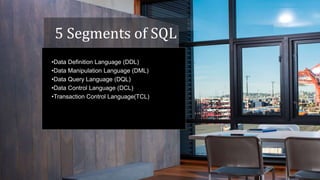
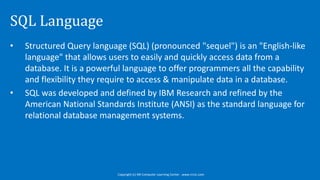
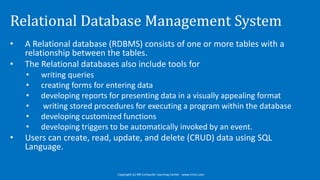
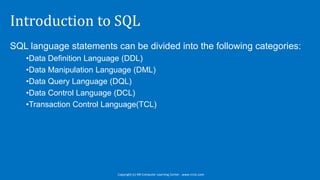

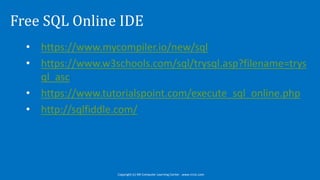

![Copyright (c) NR Computer Learning Center . www.nrclc.com
DDL: Create Table Command
Syntax
CREATE TABLE table_name
(column_name data-type [NOT NULL] [, ...]
[, PRIMARY KEY (pcolumn_name [, ...])]
FOREIGN KEY (fcolumn_name) REFERENCES ref_table_name[,...]])
[CHECK (condition)];](https://image.slidesharecdn.com/introductiontosql-ss-230630234418-a1875bfb/85/Introduction-to-SQL-9-320.jpg)




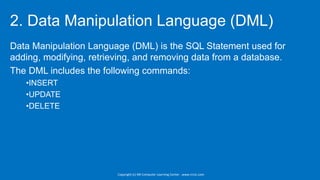



![Copyright (c) NR Computer Learning Center . www.nrclc.com
3. Data Query Language (DQL)
DQL is the SQL Statement used for retrieving data from one or more
tables using the SELECT command.
Syntax:
SELECT [DISTINCT] {* | column_name | expression [, ...]}
FROM table_name [, ...]
[WHERE condition ]
[GROUP BY column_name [, ...] [HAVING condition]]
UNION [ALL] select _statement
[ORDER BY {column_name | column_number } [{ASC|DESC}] [, ...]];](https://image.slidesharecdn.com/introductiontosql-ss-230630234418-a1875bfb/85/Introduction-to-SQL-18-320.jpg)




![Copyright (c) NR Computer Learning Center . www.nrclc.com
4. Data Control Language (DCL)
âĒ GRANT Command is used for assigning privileges to a user on the
database objects.
Syntax:
GRANT privilege [, ...] ON [TABLE] table_name
TO {user_id [, ...] | PUBLIC };
Example:
GRANT insert ON TABLE Emp TO smith;
âĒ REVOKE command is used to revoke privileges from a user in
performing an action on a database object.
Syntax:
REVOKE privilege [, ...] ON [TABLE] table_name
FROM { user_id [, ...] | PUBLIC};
Example:
Revoke insert on table Emp from smith;](https://image.slidesharecdn.com/introductiontosql-ss-230630234418-a1875bfb/85/Introduction-to-SQL-23-320.jpg)
